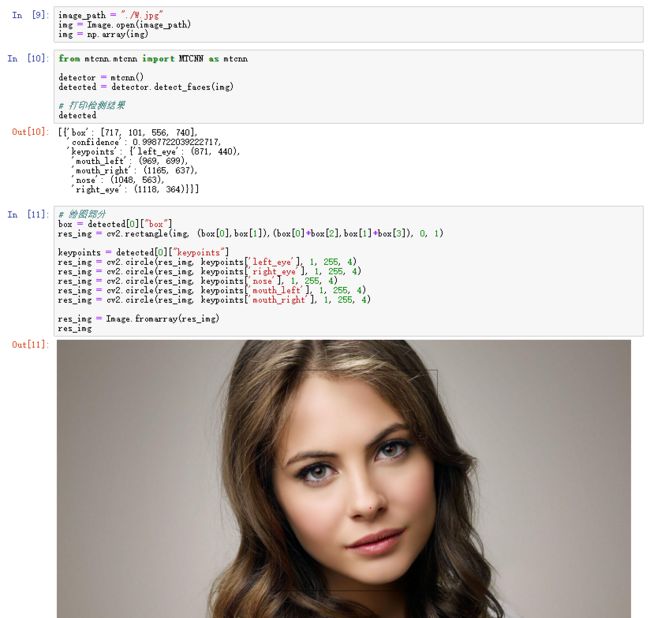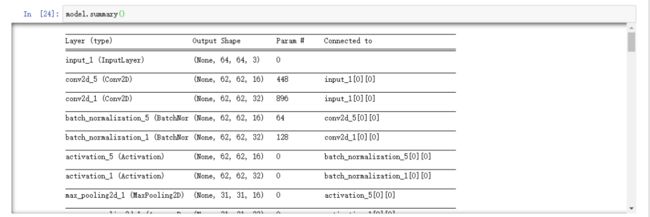【玩转华为云】手把手教你利用ModelArts实现人脸年龄预测
![]()
本篇推文共计2000个字,阅读时间约3分钟。
华为云—华为公司倾力打造的云战略品牌,2011年成立,致力于为全球客户提供领先的公有云服务,包含弹性云服务器、云数据库、云安全等云计算服务,软件开发服务,面向企业的大数据和人工智能服务,以及场景化的解决方案。
![]()
华为云用在线的方式将华为30多年在ICT基础设施领域的技术积累和产品解决方案开放给客户,致力于提供稳定可靠、安全可信、可持续创新的云服务,做智能世界的“黑土地”,推进实现“用得起、用得好、用得放心”的普惠AI。华为云作为底座,为华为全栈全场景AI战略提供强大的算力平台和更易用的开发平台。
![]()
华为云官方网站
ModelArts是华为云产品中面向开发者的一站式AI开发平台,为机器学习与深度学习提供海量数据预处理及半自动化标注、大规模分布式Training、自动化模型生成,及端-边-云模型按需部署能力,帮助用户快速创建和部署模型,管理全周期AI工作流。
![]()
华为云官方网站
![]()
手把手教你利用ModelArts实现人脸年龄预测
年龄预测,是指自动识别出一张图片中人物的年龄。这项技术有很多应用,如视频监控、产品推荐、人机交互、市场分析、用户画像、年龄变化预测等。
年龄预测场景
年龄预测场景
本实验将对图片中的人脸进行识别并根据人脸进行年龄预测。本实验将首先使用MTCNN模型检测出人脸区域,然后根据人脸区域使用SSR-Net模型预测年龄。
年龄检测结果图
实验将介绍如何利用华为云一站式AI开发平台ModelArts中的Notebook开发环境进行模型代码部署,使用和调试模型,预测出图片中人物的年龄。
ModelArts集成了基于开源的Jupyter Notebook,Jupyter Notebook是一个交互式笔记本,支持运行 40 多种编程语言。可为用户提供在线的交互式开发调试工具。用户无需关注安装配置,在ModelArts管理控制台直接使用Notebook,编写和调试模型训练代码,然后基于该代码进行模型的训练。
Notebook开发环境代码运行图
![]()
手把手利用ModelArts进行人脸年龄预测
1.准备实验环境
2.数据和代码下载
3.mtcnn库快速检测人脸
4.MTCNN模型实现检测人脸
5.SSR-Net模型预测年龄
6.实验小结
1
1.1密钥准备
首先需要进入华为云官方网站
https://www.huaweicloud.com/
![]()
点击页面的“控制台”切换至控制台界面,在账号名称的下拉菜单中点击“我的凭证”,进入创建管理访问密钥(AK/SK)的界面。位置如下图所示:
![]()
什么是访问密钥?
访问密钥即AK/SK(Access Key ID/Secret Access Key),是您通过开发工具(API、CLI、SDK)访问华为云时的身份凭证,不能登录控制台。系统通过AK识别访问用户的身份,通过SK进行签名验证,通过加密签名验证可以确保请求的机密性、完整性和请求者身份的正确性。
选择“访问密钥”,点击“新增访问密钥”
![]()
妥善保存系统自动下载的“credentials.csv”文件中的AK(Access Key Id)和SK(Secret Access Key)以备后续步骤使用。
![]()
1.2 创建Notebook开发环境
进入ModelArts主页:
https://console.huaweicloud.com/modelarts/?region=cn-north-4#/dashboard
选择全局配置:
进入全局配置页面后,点击“添加访问密钥”
打开1.1下载的csv文件:
填写访问密钥后,点击确定即可:
在ModelArts服务主界面依次点击“开发环境”、“Notebook”、“创建”
点击了“创建”后,填写创建Notebook所需的参数:
名称:自定义
工作环境:Python3
资源池:公共资源池
类型:GPU
规格:[限时免费]体验规格GPU版
存储配置:EVS
磁盘规格:5GB
配置好Notebook参数后,点击下一步,进入Notebook信息预览。
确认无误后,点击“立即创建”
创建完成后,返回开发环境主界面,等待Notebook创建完毕:
点击进入刚才创建的Notebook:
创建一个Python3环境的的Notebook。点击右上角的"New"
然后选择TensorFlow 1.13.1开发环境。
点击左上方的文件名"Untitled"
输入一个与本实验相关的名称,如"age_face"
在Notebook中,我们输入一个简单的打印语句:
print("Hello,world!")点击上方的运行按钮:
可以查看语句执行的结果:
至此,开发环境准备好啦,
我们接下来可以开始写代码了!
2
2.1数据和代码下载
运行下面代码,进行数据和代码的下载和解压:
from modelarts.session import Session
sess = Session()
if sess.region_name == 'cn-north-1':
bucket_path="modelarts-labs/notebook/DL_face_age_prediction/ssr.tar"
elif sess.region_name == 'cn-north-4':
bucket_path="modelarts-labs-bj4/notebook/DL_face_age_prediction/ssr.tar"
else:
print("请更换地区到北京一或北京四")
sess.download_data(bucket_path=bucket_path, path="./ssr.tar")运行结果如下:
运行下面代码,解压下载好的ssr.tar文件:
!tar -xf ssr.tar运行结果如下:
至此,数据和代码准备完毕。
3
3.1mtcnn库快速检测人脸
运行下面代码,安装mtcnn库:
!pip install mtcnn==0.0.8运行结果如下:
使用mtcnn库检测人脸,这种使用方式比较简单,但是无法对mtcnn库自带的人脸检测模型进行调优。在此,可体验一下这个库的用法。
运行下面代码:
import numpy as np
import cv2
import tensorflow as tf
import random
from PIL import Image运行结果如下:
可以通过Notebook的upload功能上传测试图片:
这里上传的是我准备好的两张照片,当然也可以用自己的照片。
上传好照片,就可以开始测试,运行下面代码:
image_path = "./M.jpg"
img = Image.open(image_path)
img = np.array(img)image_path的路径改为你的照片上传后所在路径。
调用mtcnn库,进行人脸区域检测:
from mtcnn.mtcnn import MTCNN as mtcnn
detector = mtcnn()
detected = detector.detect_faces(img)
# 打印检测结果
detected运行结果如下:
将检测结果绘制在图片上:
# 绘图部分
box = detected[0]["box"]
res_img = cv2.rectangle(img, (box[0],box[1]),(box[0]+box[2],box[1]+box[3]), 0, 1)
keypoints = detected[0]["keypoints"]
res_img = cv2.circle(res_img, keypoints['left_eye'], 1, 255, 4)
res_img = cv2.circle(res_img, keypoints['right_eye'], 1, 255, 4)
res_img = cv2.circle(res_img, keypoints['nose'], 1, 255, 4)
res_img = cv2.circle(res_img, keypoints['mouth_left'], 1, 255, 4)
res_img = cv2.circle(res_img, keypoints['mouth_right'], 1, 255, 4)
res_img = Image.fromarray(res_img)
res_img运行结果如下:
试试另外一张图片,运行结果如下:
4
4.MTCNN模型实现检测人脸
MTCNN网络分为三部分:PNet RNet ONet
如上所示,数据依次经过PNet,RNet和ONet,每经过一组网络,就进行一次NMS和边界框回归,最后在ONet网络输出中获得检测结果,人脸区域坐标及人脸关键点坐标。
NMS(non maximum suppression)非极大值抑制
当进行人脸检测时,可能会对同一张人脸区域有多个边界框检测结果,虽然这些检测结果都有很高的置信度,但是只需要置信度最高的检测结果,所以进行局部最大值检测,将不是最大值的预测结果去掉,完成边界框筛选的任务。
NMS被应用在很多目标检测模型当中,例如R-CNN,Faster R-CNN,Mask R-CNN等。
接下来,我们使用代码搭建MTCNN神经网络结构:
from src.align.detect_face import Network
from src.align.detect_face import rerec, pad
from src.align.detect_face import nms
from src.align.detect_face import imresample
from src.align.detect_face import generateBoundingBox运行结果如下:
PNet
我们使用全卷积网络:Proposal 网络(PNet),来生成人脸区域备选框,备选框通过边界框回归进行校正。校正后,应用NMS来将高度重复的备选框进行筛选。
PNet构建代码如下所示:
class PNet(Network):
def setup(self):
(self.feed('data')
.conv(3, 3, 10, 1, 1, padding='VALID', relu=False, name='conv1')
.prelu(name='PReLU1')
.max_pool(2, 2, 2, 2, name='pool1')
.conv(3, 3, 16, 1, 1, padding='VALID', relu=False, name='conv2')
.prelu(name='PReLU2')
.conv(3, 3, 32, 1, 1, padding='VALID', relu=False, name='conv3')
.prelu(name='PReLU3')
.conv(1, 1, 2, 1, 1, relu=False, name='conv4-1')
.softmax(3,name='prob1'))
(self.feed('PReLU3')
.conv(1, 1, 4, 1, 1, relu=False, name='conv4-2'))RNet
RNet生成的所有人脸备选框都被输入另一个卷积网络,叫做Refine网络(RNet)。RNet将大量错误的人脸信息去掉,同样通过边界框回归进行校正,以及通过NMS进行筛选。
RNet构建代码如下所示:
class RNet(Network):
def setup(self):
(self.feed('data') #pylint: disable=no-value-for-parameter, no-member
.conv(3, 3, 28, 1, 1, padding='VALID', relu=False, name='conv1')
.prelu(name='prelu1')
.max_pool(3, 3, 2, 2, name='pool1')
.conv(3, 3, 48, 1, 1, padding='VALID', relu=False, name='conv2')
.prelu(name='prelu2')
.max_pool(3, 3, 2, 2, padding='VALID', name='pool2')
.conv(2, 2, 64, 1, 1, padding='VALID', relu=False, name='conv3')
.prelu(name='prelu3')
.fc(128, relu=False, name='conv4')
.prelu(name='prelu4')
.fc(2, relu=False, name='conv5-1')
.softmax(1,name='prob1'))
(self.feed('prelu4') #pylint: disable=no-value-for-parameter
.fc(4, relu=False, name='conv5-2'))ONet
ONet与RNet相似,但是在ONet将输出5个人脸关键点位置,全称为Output Network,作为最后一层网络,将输出人脸区域坐标以及人脸关键点坐标。
ONet构建代码如下所示:
class ONet(Network):
def setup(self):
(self.feed('data') #pylint: disable=no-value-for-parameter, no-member
.conv(3, 3, 32, 1, 1, padding='VALID', relu=False, name='conv1')
.prelu(name='prelu1')
.max_pool(3, 3, 2, 2, name='pool1')
.conv(3, 3, 64, 1, 1, padding='VALID', relu=False, name='conv2')
.prelu(name='prelu2')
.max_pool(3, 3, 2, 2, padding='VALID', name='pool2')
.conv(3, 3, 64, 1, 1, padding='VALID', relu=False, name='conv3')
.prelu(name='prelu3')
.max_pool(2, 2, 2, 2, name='pool3')
.conv(2, 2, 128, 1, 1, padding='VALID', relu=False, name='conv4')
.prelu(name='prelu4')
.fc(256, relu=False, name='conv5')
.prelu(name='prelu5')
.fc(2, relu=False, name='conv6-1')
.softmax(1, name='prob1'))
(self.feed('prelu5') #pylint: disable=no-value-for-parameter
.fc(4, relu=False, name='conv6-2'))
(self.feed('prelu5') #pylint: disable=no-value-for-parameter
.fc(10, relu=False, name='conv6-3'))三个网络代码运行结果如下:
网络代码运行结束后,进行数据准备:
# 打开原图
test_img = Image.open(image_path)
test_img运行结果如下:
图片预处理:
# 进行图片预处理
test_img = np.array(test_img)
img_size = np.asarray(test_img.shape)[0:2]
factor_count=0
minsize = 20
total_boxes=np.empty((0,9))
points=np.empty(0)
h=test_img.shape[0] # h=410
w=test_img.shape[1] # w=599
minl=np.amin([h, w]) # minl = [410,599] 中最小值 410
m=12.0/minsize # m=12/20
minl=minl*m # minl = 410*12/20 = 410* 0.6
factor = 0.709
scales=[]
while minl>=12:
scales += [m*np.power(factor, factor_count)]
minl = minl*factor
factor_count += 1
# first stage
for scale in scales:
hs=int(np.ceil(h*scale)) #大于等于该值的最小整数
ws=int(np.ceil(w*scale))
im_data = cv2.resize(test_img, (ws, hs), interpolation=cv2.INTER_AREA)
im_data = (im_data-127.5)*0.0078125
img_x = np.expand_dims(im_data, 0)
img_y = np.transpose(img_x, (0,2,1,3))运行结果如下:
运行PNet
运行PNet,并加载预训练权重:
with tf.Graph().as_default():
with tf.Session() as sess:
with tf.variable_scope('pnet'):
data = tf.placeholder(tf.float32, shape=(None, None, None, 3), name="input")
pnet = PNet({'data':data})
pnet.load("./src/align/PNet.npy", sess)
out = sess.run(('pnet/conv4-2/BiasAdd:0', 'pnet/prob1:0'), feed_dict={'pnet/input:0':img_y})
# boundingbox regression 结果
out0 = np.transpose(out[0], (0,2,1,3))
# face classification 结果
out1 = np.transpose(out[1], (0,2,1,3))
threshold = 0.5
boxes, reg = generateBoundingBox(out1[0,:,:,1].copy(), out0[0,:,:,:].copy(), scale, threshold)
print("PNet产生结果为:"+str(boxes.shape))
total_boxes = boxes.copy()运行结果如下:
边界框绘制函数:
# 边界框绘制函数
def draw_bboxes(img, total_boxes):
for i in range(total_boxes.shape[0]):
r = random.randint(0, 255)
g = random.randint(0, 255)
b = random.randint(0, 255)
x1 = int(total_boxes[:,0][i])
y1 = int(total_boxes[:,1][i])
x2= int(total_boxes[:,2][i])
y2 = int(total_boxes[:,3][i])
img = cv2.rectangle(img,(x1,y1),(x2,y2), (r,g,b), 2)
return img运行结果如下:
将PNet预测结果进行筛选和回归,
结果绘制在图片上:
img = Image.open(image_path)
img = np.array(img)
Image.fromarray(draw_bboxes(img,total_boxes))
total_boxes=np.empty((0,9))
pick = nms(boxes.copy(), 0.7, 'Union')
if boxes.size>0 and pick.size>0:
boxes = boxes[pick,:]
total_boxes = np.append(total_boxes, boxes, axis=0)
print("筛选之后结果为:"+str(total_boxes.shape))
# 绘制筛选后的边界框
img = Image.open(image_path)
img = np.array(img)
# 进行nms计算 参数为0.7
pick = nms(total_boxes.copy(), 0.6, 'Union')
total_boxes = total_boxes[pick,:]
print(total_boxes.shape)
# 边界框回归
regw = total_boxes[:,2]-total_boxes[:,0]
regh = total_boxes[:,3]-total_boxes[:,1]
qq1 = total_boxes[:,0]+total_boxes[:,5]*regw
qq2 = total_boxes[:,1]+total_boxes[:,6]*regh
qq3 = total_boxes[:,2]+total_boxes[:,7]*regw
qq4 = total_boxes[:,3]+total_boxes[:,8]*regh
total_boxes = np.transpose(np.vstack([qq1, qq2, qq3, qq4, total_boxes[:,4]]))
print(total_boxes.shape)
img = Image.open(image_path)
img = np.array(img)
# 将边界框形状转为正方形
total_boxes = rerec(total_boxes.copy())
print(total_boxes)
# 将边界框坐标整理成整数
total_boxes[:,0:4] = np.fix(total_boxes[:,0:4]).astype(np.int32)
print(total_boxes)
dy, edy, dx, edx, y, ey, x, ex, tmpw, tmph = pad(total_boxes.copy(), w, h)
img = Image.open(image_path)
img = np.array(img)
Image.fromarray(draw_bboxes(img,total_boxes))运行结果如下:
运行RNet
MTCNN的PNet计算结束后,可以看到已经有若干个边界框已经被预测出来。接下来我们将进行RNet预测,通过RNet预测之后,边界框将更加准确。
numbox = total_boxes.shape[0]
tempimg = np.zeros((24,24,3,numbox))
for k in range(0,numbox):
tmp = np.zeros((int(tmph[k]),int(tmpw[k]),3))
tmp[dy[k]-1:edy[k],dx[k]-1:edx[k],:] = img[y[k]-1:ey[k],x[k]-1:ex[k],:]
if tmp.shape[0]>0 and tmp.shape[1]>0 or tmp.shape[0]==0 and tmp.shape[1]==0:
tempimg[:,:,:,k] = imresample(tmp, (24, 24))
else:
print(0)
tempimg = (tempimg-127.5)*0.0078125
tempimg1 = np.transpose(tempimg, (3,1,0,2))
with tf.Graph().as_default():
with tf.Session() as sess:
with tf.variable_scope('rnet'):
data = tf.placeholder(tf.float32, shape=(None, 24, 24, 3), name="input")
rnet = RNet({'data':data})
rnet.load("./src/align/RNet.npy", sess)
out = sess.run(('rnet/conv5-2/conv5-2:0', 'rnet/prob1:0'), feed_dict={'rnet/input:0':tempimg1})
# 检测到的人脸坐标
out0 = np.transpose(out[0])
out1 = np.transpose(out[1])
score = out1[1,:]
threshold = 0.7
ipass = np.where(score>0.2)
total_boxes = np.hstack([total_boxes[ipass[0],0:4].copy(), np.expand_dims(score[ipass].copy(),1)])
mv = out0[:,ipass[0]]
if total_boxes.shape[0]>0:
pick = nms(total_boxes, threshold, 'Union')
total_boxes = total_boxes[pick,:]
print(total_boxes)
img = Image.open(image_path)
img = np.array(img)
from src.align.detect_face import bbreg
# 边界框回归
total_boxes = bbreg(total_boxes.copy(), np.transpose(mv[:,pick]))
print(total_boxes)
# 边界框整理成正方形
total_boxes = rerec(total_boxes.copy())
print(total_boxes)
img = Image.open(image_path)
img = np.array(img)
Image.fromarray(draw_bboxes(img,total_boxes))运行结果如下:
运行ONet
最后,我们进行ONet预测,不仅使人脸的边界框检测更加准确,这一步还将关键点检测出来。
numbox = total_boxes.shape[0]
total_boxes = np.fix(total_boxes).astype(np.int32)
dy, edy, dx, edx, y, ey, x, ex, tmpw, tmph = pad(total_boxes.copy(), w, h)
tempimg = np.zeros((48,48,3,numbox))
for k in range(0,numbox):
tmp = np.zeros((int(tmph[k]),int(tmpw[k]),3))
tmp[dy[k]-1:edy[k],dx[k]-1:edx[k],:] = img[y[k]-1:ey[k],x[k]-1:ex[k],:]
if tmp.shape[0]>0 and tmp.shape[1]>0 or tmp.shape[0]==0 and tmp.shape[1]==0:
tempimg[:,:,:,k] = imresample(tmp, (48, 48))
else:
print(0)
tempimg = (tempimg-127.5)*0.0078125
tempimg1 = np.transpose(tempimg, (3,1,0,2))
with tf.Graph().as_default():
with tf.Session() as sess:
with tf.variable_scope('onet'):
data = tf.placeholder(tf.float32, shape=(None, 48, 48, 3), name="input")
onet = ONet({'data':data})
rnet.load("./src/align/ONet.npy", sess)
out = sess.run(('onet/conv6-2/conv6-2:0', 'onet/conv6-3/conv6-3:0', 'onet/prob1:0'), feed_dict={'onet/input:0':tempimg1})
# 人脸区域边界框预测结果
out0 = np.transpose(out[0])
# 人脸关键点预测结果
out1 = np.transpose(out[1])
# 人脸区域置信度
out2 = np.transpose(out[2])
score = out2[1,:]
points = out1
# threshold = 0.7
ipass = np.where(score>0.7)
points = points[:,ipass[0]]
total_boxes = np.hstack([total_boxes[ipass[0],0:4].copy(), np.expand_dims(score[ipass].copy(),1)])
mv = out0[:,ipass[0]]
w = total_boxes[:,2]-total_boxes[:,0]+1
h = total_boxes[:,3]-total_boxes[:,1]+1
points[0:5,:] = np.tile(w,(5, 1))*points[0:5,:] + np.tile(total_boxes[:,0],(5, 1))-1
points[5:10,:] = np.tile(h,(5, 1))*points[5:10,:] + np.tile(total_boxes[:,1],(5, 1))-1
if total_boxes.shape[0]>0:
total_boxes = bbreg(total_boxes.copy(), np.transpose(mv))
pick = nms(total_boxes.copy(), 0.7, 'Min')
total_boxes = total_boxes[pick,:]
points = points[:,pick]
img = Image.open(image_path)
img = np.array(img)
r = random.randint(0, 255)
g = random.randint(0, 255)
b = random.randint(0, 255)
point_color = (r, g, b)
for i in range(5):
cv2.circle(img,(int(points[i]),int(points[i+5])),1, point_color, 4)
Image.fromarray(draw_bboxes(img,total_boxes))运行结果如下:
5
5.SSR-Net模型预测年龄
我们使用SSR-Net模型预测年龄:
首先我们将模型结构和权重加载,预训练模型位置存储在weight_file中。
from SSRNET_model import SSR_net
weight_file = "./ssrnet_3_3_3_64_1.0_1.0.h5"
img_size = 64
stage_num = [3,3,3]
lambda_local = 1
lambda_d = 1
model = SSR_net(img_size,stage_num, lambda_local, lambda_d)()
model.load_weights(weight_file)运行结果如下:
模型层级结构,运行下面代码,可查看模型的各层级结构:
model.summary()运行结果如下:
准备输入数据:
faces = np.empty((len(detected), img_size, img_size, 3))
faces.shape运行结果如下:
获取人脸区域图片,并缩放
将人脸检测结果进行裁剪和缩放
ad = 0.4
img_h, img_w, _ = np.shape(img)
for i,d in enumerate(detected):
if d['confidence'] >=0.95 :
x1,y1,w,h = d['box']
x2 = x1 + w
y2 = y1 + h
xw1 = max(int(x1 - ad * w), 0)
yw1 = max(int(y1 - ad * h), 0)
xw2 = min(int(x2 + ad * w), img_w - 1)
yw2 = min(int(y2 + ad * h), img_h - 1)
img = cv2.resize(img[yw1:yw2+1, xw1:xw2+1, :], (img_size, img_size))
faces[i,:,:,:] = img
res_img = Image.fromarray(img)
res_img运行结果如下:
预测年龄
将人脸区域图片输入模型,获得预测结果
res = model.predict(faces)
print("预测年龄为:"+str(int(res[0])))运行结果如下:
至此,年龄预测实验结束。
最后,大家使用的云端资源记得全部删除或停用,如本次实验的Notebook开发环境,实验结束后记得停用或删除,以免造成不必要的花费。
6
6.实验小结
通过本次实验,学习到的是如何在华为云ModelArts的Notebook开发环境中使用MTCNN模型进行人脸区域检测,同时学习了如何使用SSR-Net模型预测年龄,并且学习了如何在华为云ModelArts的Notebook开发环境中调试代码。
如果大家对结果不太满意,可以试着在代码中进行调参,以提高检测的精确度,或者试着用你的照片来检测一下,看看你的预测年龄。
文中涉及到的MTCNN模型,SSR-Net模型的论文,以及代码已经整理完毕。
可后台回复“年龄预测”
获取上述资源。
![]()
如果看了这么多,您也想体验一下华为云AI的魅力,可点击下方[阅读全文]活动链接,参加已于5月18日开始的
《2020|华为云AI实战营》
与华为云技术专家和全国华为云AI爱好者们一起领略华为云AI魅力,让你轻松Get AI技能,获取丰厚的奖品,一起升级打怪,变成最好的自己。
风里雨里,华为与我,在等你!
![]()
华为,中国骄傲!中华有为!
![]()
往期回顾
【玩转华为云】这个夏日,我与华为云青年班AI实战营的遇见
华为加油,中国加油!
欢迎各位读者在下方进行提问留言
☆ END ☆
![]()
你与世界
只差一个
公众号
扫描上方二维码,获取千元“编程学习资料”大礼包











































